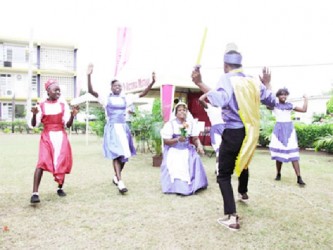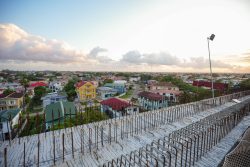One of the most powerful poems by Trinidad and Tobago’s controversial poet Eric Roach is one called ‘Verse in August.’ Roach, a fairly minor poet in the hierarchy of West Indian writers raises interest and controversy because of the contradictory state of his politics as expressed in his poetry, drama and criticism. At one juncture he seemed a firm progressive Africanist while at another the ‘dark clouds’ of Black activism and revolutionary poetic developments drew his denunciation and drove him into depression between 1970 and 1974.
Despite crying down the new radical black poetry as backward and unprogressive “wallowing in the murky waters of race and slavery,” he wrote a play Calabash of Blood set in slavery and the resounding, vibrant verses of the poem ‘Verse in August.’
draw bow
on fiddle strings
let rhythm jump
and catgut screech
let all time jig
a kalinda and reel
these august freedom days
let dead bones rise
and dance their own bongos
who’ll dance my death farewell?
who’ll trample me a rhythm on my
grave?
‘bongo macedonia
viniway viniway bongo’ . . .

I have quoted this poem before and have mentioned Roach more than once in the context of the anniversary of Emancipation and related matters. But I will continue to repeat this reference because he was such an interesting, if troubled, poet. Moreover, his ‘Verse In August’ is about the best example of a lamentation in lively dramatic lines over the moribund state of affairs in Caribbean traditions to celebrate Emancipation. His “these August freedom days” is a reference to the First of August anniversary of “freedom” while the other lines about “dead bones” rising to “dance their own bongos” is a sarcastic remark that they will have to do so since no one today will do it for them. Roach laments the waning of those traditions, while truly celebrating them.
Relatively few cultural and performance traditions have survived since they developed in the nineteenth century and were celebrated on the anniversary of Emancipation. The bongo is a good example. It is a faded African dance for the dead, known in Trinidad and Tobago where it was probably still practised 50 years ago. It is a spiritual dance performed by the initiated at the death of someone, to send them off properly to the next stage of the life cycle. This rite of passage was important because it was derived from the ancestor worship prevalent in African traditional religions and spiritual beliefs. Many different rituals were performed in different cultures to allow the deceased smooth passage out of his present stage in the life cycle and into the realm of the ancestors. The bongo is one of them. This ritual dance is accompanied by the bongo drums, whose rhythms have to be learned to invoke the spirits. Roach refers to it as an example of vanished First of August activities.
Among the most distinctive traditional dances known in Jamaica as an Emancipation performance is the brukins. Its origins are in the celebrations to mark the end of slavery most likely in 1838 and it is a very typical traditional masquerade with a visible mixture of European and African influences. The costumed dancers form themselves in a royal procession led by king and queen followed by courtiers and masquerade figures. They are accompanied by a group of drummers – drums and katta stick percussion. The parade moves from one point to the next, in the old tradition, from house to house.
The performers are regal and stately and demonstrate both English and African influences. It is obviously an English royal procession and the costumes suggest this – an imitation of monarchs and regalia with the lead dancers, king and queen wearing crowns and carrying a mace. The dance is African, each dancer with an upright body posture, head and shoulders angled backwards. The name ‘brukins’ (bruckings) probably comes from the dance moves which have stately steps punctuated by a very sudden and explosive ‘bruck’ and ‘dip’ – bending of the knees, and a contortion of the body.
Kings and queens are ubiquitous in these African derived traditions, particularly in those that have an element of rivalry and competition, which is not unknown in brukins and in masquerade (jonkunnu). Crowning and monarchs are common. This dance is also associated with the traditional song ‘Aagas Maanin’ (August Morning), which we have mentioned before. It is worth mentioning again because it is most prominent among emancipation performances out of Jamaica. It also fits in here because of its reference to Queen Victoria – not only reference, but reverence. The lines below do not faithfully represent the exact order of the lines in the lyrics of the song. These are the actual words although the order of the

verses might be mixed up; but that is how it is traditionally performed – the lead singers take the liberty to sing the lines in whatever order they choose.
Augas maanin come again
Aagas maanin jubilee
Queen Victoria gi we free
Queen Victoria Jubilee
Jubilee jubilee
Dis is de time of Jubilee
Queen Victoria gi we free
Queen Victoria Jubilee
Aagas maanin come again
Aagas maanin jubilee
Queen Victoria gi we free
Queen Victoria jubilee
Jubilee jubilee
Aagas maanin jubilee
Queen Victoria gi we free
Dis is de time of jubilee.
There is a very significant, if curious, mixture of references to Emancipation itself, to the 50th anniversary – the ‘Golden Jubilee’ of Emancipation in 1888, and the Golden Jubilee of Victoria in 1887. Victoria’s anniversary was widely celebrated around the Caribbean, and this song obviously dates back to that time. Both ‘Jubilees’ are mixed together in the lyrics, which must be dated in or after 1888. Although the 50th year of the British Queen’s reign was in 1887, she comes in for prominent reference in the song for a number of reasons.
Victoria holds a very high position in the esteem of the liberated Africans who credit her with the abolition of slavery. She was therefore sung and fabled. (The Guyanese village of Victoria, bought by former enslaved, was named in her honour. There is a large public hospital in Kingston, Jamaica named the Victoria Jubilee Hospital.) The 1887 commemorations still rung across the Caribbean in 1888 (see John Cowley, Carnival, Canboulay and Calypso) and she was duly remembered when the 50th anniversary of the end of slavery was equally widely feted across the region.
CLR James in Black Jacobins refers to the strong “African belief in a monarchy” in the Toussaint led Haitian Revolution. Such a belief is certainly reflected in several performance traditions with origins in slavery or the post-emancipation period. It is certainly in evidence in these Emancipation theatricals. There is reference to two groups of dancers in the brukins, one dressed in red, one in blue, an imitation of the Red and Blue Set Girls in the nineteenth century junkunnu – itself an imitation of the two royal houses of England.
This very easily tied in with the strong tradition of rivalry among the Africans which found itself in many customs and performances out of which winners were ‘crowned’ or which were led by a ‘queen’ – very notable in carnival, in calypso, and in Emancipation celebratory theatrics.






